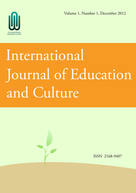


Volume 12 Issues 3-4 (2023-12-31)
Volume 12 Issues 1-2 (2023-06-30)
Volume 10 Issues 1&2 (2021-06-30)
Volume 9 Issues 3&4 (2020-12-31)
Volume 9 Issues 1&2 (2020-06-30)
Volume 8 Issues 3&4 (2019-12-31)
Volume 8 Issues 1&2 (2019-06-30)
Volume 7 Issues 3&4 (2018-12-31)
Volume 7 Issues 1&2 (2018-06-30)
Volume 6 Issues 3&4 (2017-12-31)
Volume 6 Issues 1&2 (2017-06-30)
Volume 5 Issues 3&4 (2016-12-31)
Volume 5 Issues 1&2 (2016-06-30)
Volume 4 Issues 3&4 (2015-12-31)
Linguistic competence and pragmatic competence are the two additive components of communicative competence. However, teaching and assessing pragmatic competence has often been neglected in EFL education in China. Using a faculty survey, this study examined Chinese college English teachers’ readiness in teaching and assessing their students’ English pragmatic competence. One hundred and thirty English teachers from four Chinese universities participated in this study. The results of this study indicate that the majority of Chinese college English teachers are aware of the importance of pragmatic competence in teaching and assessing their students’ English language proficiency; most of them have a basic understanding of the nature and complexity of teaching and assessing pragmatic competence; and therefore, they are kind of ready for the inclusion of pragmatic competence in both their EFL instruction and assessment practices. Important implications for teaching and assessing Chinese college students’ English pragmatic competence are discussed.
Parts of this contributing article for educators was taken from a presentation given on December 1, 2022 by Dr. Patrice J. Pinder in collaboration with the University of the West Indies’ (UWI) Mona Faculty of Science and Technology who hosted a UNESCO sponsored Disaster Heritage Webinar, i.e., Disaster heritage – Jamaica National Commission for UNESCO (jncunesco.gov.jm). The webinar presentation focused specifically on natural disasters such as catastrophic storms or hurricanes like the powerful Category 5 Storm—Hurricane Dorian, which hit the Bahamas’ northern islands of Abaco and Grand Bahama on September 1, 2019. Hurricane Dorian caused major damages to homes and properties, and resulted in loss of lives. The presentation and this current paper were developed as educational advisory guides to give teachers and other education professionals ideas on how to help young children to cope after natural disasters. Thus, it is important for teachers to help young children (students) to undergo various coping mechanisms in order to build resilience. Using stories/storytelling sessions, games, and comic sketches are some of the suggested tools and strategies that can be used with young children to help them better cope after psychologically disturbing events like the Bahamas’ Hurricane Dorian.
This study engaged a cohort of 214 psychology students from a British university in a comprehensive examination of the relationship between music tempo and walking speed. Extending the findings of previous studies that highlighted reduced shopping durations in response to loud music; this study delved into the potential of faster music tempos to augment walking speed. The experimental design meticulously replicated a retail context within a controlled laboratory environment, both with and without ambient music, in line with established methodologies. Participants undertook treadmill walking, covering a total distance of 2 x 1 km across four distinct tempo conditions. The independent variable encompassed the music tempo, while the study assessed variations in walking speed alongside the intricate tapestry of personality traits as dependent variables. Findings gleaned from One-way ANOVA analysis unveiled no significant impact of music tempo on walking speed in scenarios where music preceded the walking session. Strikingly, a noteworthy effect materialized when music intervention occurred during the latter session. Additionally, the study’s exploration into the relationship between changes in walking speed and individual personality traits revealed a nuanced and modest correlation. Through this rigorous investigation, a deeper understanding of the interplay between music, walking behaviour, and individual disposition is elucidated.